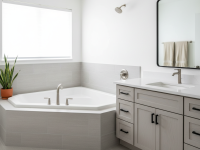Breathe Easier: My Personal Journey to Allergy Relief with Natural Air Purifier Plants
Hey there, fellow allergy sufferer! Do you ever feel like you’re constantly battling a stuffy nose, itchy eyes, and an endless cycle of sneezes, even inside your own home? Trust me, I’ve been there. For years, my home felt less like a sanctuary and more like a pollen-laden battlefield. I tried everything – air purifiers with fancy filters, meticulous cleaning, avoiding certain foods – but the relief was always temporary. That is, until I discovered the incredible, understated power of natural air purifier plants.
What if I told you that some of the most beautiful and unassuming members of the plant kingdom could be your secret weapon against indoor allergens and pollutants? It sounds almost too good to be true, doesn’t it? But my personal experience has turned me into a true believer. Come along as I share my journey from chronic allergy woes to breathing cleaner, easier, thanks to my leafy green companions.
My Allergy Story: A Constant Battle
Let me paint you a picture: I used to wake up almost every morning feeling congested, regardless of the season. Spring and autumn were obviously brutal, but even in the dead of winter, I’d be sniffing and sneezing. My allergist confirmed it – dust mites, pet dander (even though I don’t have pets, it travels!), mold spores, and a general sensitivity to airborne particles. My bedroom, despite regular vacuuming and dusting, always felt heavy, almost suffocating at times.
I invested in a HEPA filter air purifier, and while it helped a little, it was noisy, required filter changes, and honestly, felt like a band-aid solution. I wanted something more natural, something that felt integrated with my home, not just another appliance humming in the corner. I longed for a truly fresh indoor environment, a place where my lungs could truly relax.
The Green Revelation: How I Stumbled Upon Air Purifying Plants
It was a casual conversation with a friend, a self-proclaimed “plant parent,” that first piqued my interest. She mentioned how certain houseplants weren’t just decorative; they actively “eat” toxins from the air. My skeptical mind immediately thought, “Really? Just a plant?” But she told me about studies, including some by NASA (yes, the space agency!), that highlighted plants’ incredible ability to remove common indoor air pollutants like formaldehyde, benzene, and trichloroethylene.
Intrigued, I started my own research. I learned that these volatile organic compounds (VOCs) are emitted by everyday items – furniture, cleaning products, paints, even synthetic fabrics. And for someone like me, whose immune system is already on high alert, these invisible irritants can exacerbate allergy symptoms significantly. The idea that a simple houseplant could tackle these silent enemies without chemicals or noise was revolutionary to me.
So, I decided to take the plunge. My first plant was a small Snake Plant, partly because my friend swore by its air-purifying prowess and partly because I heard it was almost impossible to kill (a big plus for a newbie like me!). What started as an experiment quickly blossomed into a passion, and more importantly, a noticeable improvement in my allergy symptoms.
My Top Picks: Allergy-Friendly Green Heroes for Your Home
Over time, I’ve gathered a small army of green heroes that have truly transformed my home’s air quality. Here are some of my personal favorites, tried and tested in my allergy-sensitive environment:
1. The Mighty Snake Plant (Sansevieria trifasciata)
- Why it’s great for allergies: This plant is an absolute superstar. It excels at removing toxins like formaldehyde, benzene, trichloroethylene, and xylene from the air. What makes it extra special for allergy sufferers (and light sleepers!) is its unique ability to convert carbon dioxide into oxygen at night, unlike most plants that do this during the day.
- My experience: I have one in my bedroom and another in my living room. I noticed a subtle but definite improvement in how I woke up. Less stuffiness, less morning sneezing. It’s incredibly low maintenance, too, so even if you’re new to plants, you can’t go wrong.
- Care tips: Super easy! It thrives oeglect. Give it bright, indirect light, and water only when the soil is completely dry (think once every 2-4 weeks, even less in winter).
2. The Charming Spider Plant (Chlorophytum comosum)
- Why it’s great for allergies: Another fantastic choice, especially for removing formaldehyde and xylene. It’s also great at tackling carbon monoxide and other airborne pollutants.
- My experience: These plants grow quickly and produce “spiderettes” (baby plants) that you can easily propagate, which is incredibly satisfying! I have them hanging in baskets and sitting on shelves. They seem to make the air feel lighter and fresher.
- Care tips: They prefer bright, indirect light but can tolerate lower light conditions. Keep the soil consistently moist but not soggy. They’re very forgiving!
3. The Elegant Peace Lily (Spathiphyllum)
- Why it’s great for allergies: Beyond its stuing white blooms, the Peace Lily is a powerhouse for filtering out a broad range of toxins, including ammonia, benzene, formaldehyde, and trichloroethylene. Crucially for allergy sufferers, it’s also excellent at removing mold spores from the air, a common indoor allergen.
- My experience: I keep a Peace Lily in my bathroom because of its mold-fighting abilities and its love for humidity. The air in there just feels cleaner, and I’ve noticed less of that “damp” smell that used to linger.
- Care tips: It prefers indirect light and consistent moisture. Its leaves will droop dramatically when it needs water, acting as a perfect visual cue! Just be aware, it is toxic to pets if ingested, so place it out of reach.
4. The Lush Areca Palm (Dypsis lutescens)
- Why it’s great for allergies: This beautiful, feathery palm is a fantastic natural humidifier, releasing significant amounts of moisture into the air. This can be a huge benefit for allergy and asthma sufferers, as dry air can irritate respiratory passages. It’s also effective at removing benzene, formaldehyde, and carbon monoxide.
- My experience: I have a medium-sized Areca Palm in my living room, and it makes the entire space feel more vibrant and alive. The air feels less dry, which means less irritation for my nasal passages and throat.
- Care tips: It likes bright, indirect light and needs to be watered regularly to keep the soil consistently moist. It also appreciates a good misting, especially in drier climates or during winter when indoor heating can dry out the air.
5. The Versatile Golden Pothos (Epipremnum aureum)
- Why it’s great for allergies: If you want something hardy and effective, the Golden Pothos is your friend. It’s excellent at purifying the air of formaldehyde, carbon monoxide, and benzene.
- My experience: I have several of these, trailing from shelves and even in my home office. They are incredibly resilient and grow quickly, creating beautiful cascades of green. I feel like they add a fresh, vibrant touch while quietly working their air-purifying magic.
- Care tips: Very tolerant of various light conditions, from low to bright indirect. Water when the top inch or two of soil feels dry. Like the Peace Lily, it’s toxic to pets, so hang it high!
Beyond Air Cleaning: The Unexpected Perks of My Plant Companions
While the primary goal was allergy relief, I quickly discovered that bringing these plants into my life offered so many additional, unexpected benefits:
- Improved Mood and Well-being: There’s something incredibly soothing about being surrounded by greenery. My plants have become a source of peace and joy, reducing stress and adding a touch of nature to my urban apartment.
- Natural Humidification: Especially with the Areca Palm, the air in my home feels less dry, which is a huge bonus during the colder months when heating systems strip moisture from the air, often exacerbating allergy symptoms.
- Aesthetic Appeal: Let’s be honest, they look fantastic! My home feels cozier, more inviting, and alive with their presence. They’ve transformed my decor in the best way possible.
- A Sense of Accomplishment: Nurturing these plants and watching them thrive gives me a quiet sense of satisfaction. It’s a small daily ritual that coects me to something living and growing.
Getting Started: My Simple Tips for Your Green Journey
If you’re an allergy sufferer like me and considering trying out air purifying plants, here are a few practical tips based on my experience:
- Start Small: Don’t overwhelm yourself. Pick one or two plants from the list that appeal to you and see how you like them.
- Research Before You Buy: While my picks are generally easy, always double-check the specific care requirements for any plant you bring home to ensure it’s a good fit for your environment and lifestyle.
- Consider Pet Safety: If you have furry friends, always check if a plant is toxic to pets. Many popular houseplants can be harmful if ingested.
- Proper Placement is Key: Pay attention to light. Most air-purifying plants prefer bright, indirect light, but some can tolerate lower light.
- Don’t Overwater: This is probably the most common mistake. It’s easier to revive an underwatered plant than an overwatered one. Always check the soil moisture before watering.
- Wipe Down Leaves: Plants clean the air, but their leaves can also collect dust. Gently wipe them down every few weeks to help them breathe and photosynthesize better, and to keep dust out of your air.
- Quality Potting Mix: Use a good quality, well-draining potting mix. It makes a big difference in the plant’s health.
Conclusion
Embracing natural air purifier plants has been one of the most impactful changes I’ve made for my allergy-sensitive home. It’s more than just decor; it’s an investment in cleaner air, fewer symptoms, and a more serene living environment. My home feels genuinely fresher, and I wake up with far less congestion than before. While they aren’t a magic bullet that will cure all allergies, they provide a significant, natural boost to indoor air quality that has made a world of difference for me.
So, if you’re struggling with allergies and looking for a natural, beautiful, and sustainable solution, I wholeheartedly encourage you to welcome some green life into your home. You might just find that your journey to breathing easier starts with a humble pot and a leafy friend. Happy planting, and here’s to cleaner, healthier air!




